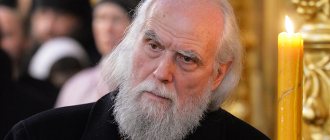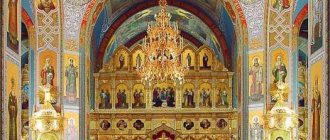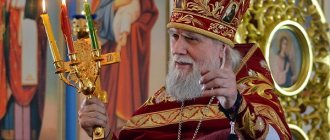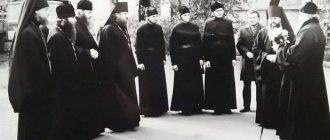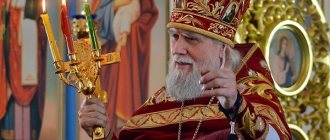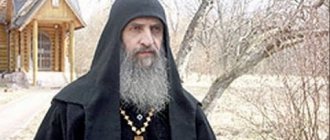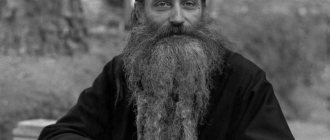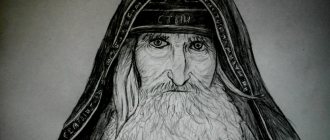Russian Orthodox Church
Born on August 3, 1977 in Kharkov.
In 1994 he graduated from secondary school No. 4 in Votkinsk (Udmurt Republic).
In 1994-99 Studied at Izhevsk State Technical University. In 1999, he defended his diploma in the specialty “Device and methods of medical diagnostics” on the topic “Study of radiation patterns of real piezoelectric transducers in a pulsed operating mode.” In 1999-2002 studied in graduate school at the same university with a specialty in “Thermal, electric rocket engines and power plants of aircraft”, at the same time (since the fall of 2001) he was obedient to the temple attendant and altar boy in the Cathedral of the Holy Blessed Prince Alexander Nevsky in Izhevsk, worked software engineer at the scientific-technical and enterprise "Gorsvet".
On June 2, 2002, in the Alexander Nevsky Cathedral of Izhevsk, Archbishop Nikolai of Izhevsk and Udmurtia ordained him to the rank of deacon. He carried the obedience of the cleric of the Alexander Nevsky Cathedral, and also accompanied the ruling bishop on trips around the diocese. He was appointed responsible for preparation for ordination and the liturgical practice of newly ordained clergy. Released from obedience as a cleric of the Alexander Nevsky Cathedral on August 22, 2007 in connection with the transition to full-time study at the Moscow Theological Seminary.
On April 6, 2008, the rector of the Moscow Theological Academy, Archbishop Eugene of Vereisky, ordained him to the rank of presbyter. On March 16, 2010, he was tonsured a monk by the same bishop.
He graduated from the seminary in June 2010, having defended his thesis on the topic “Combattimento spiritual” by Lorenzo Scupoli, “Ό Ἀόρατος Πόλεμος” by St. Nicodemus of the Holy Mountain and its translation of St. Feofan the Recluse: a comparative analysis." In June 2012, he graduated from the master's program at the Moscow Theological Academy, defending his master's thesis on the topic “The doctrine of theology in the books of the prophets Hosea and Ezekiel.”
In 2012-16 studied at the graduate school of the Moscow Theological Academy.
In 2007-2008 served as the literary editor of the MDA student magazine “Vstrecha”, in 2008-11. - editor-in-chief of the same magazine.
From September 2009 to December 2010 - freelance priest of the Donskoy Stavropegic Monastery in Moscow.
In 2012-14 served in the Church of the Holy Blessed Prince Alexander Nevsky at military unit No. 68010.
In 2012 and 2013 During the Easter and Christmas period, with the blessing of Archbishop Eugene of Vereisky and Archbishop Mark of Yegorievsky, head of the Moscow Patriarchate Office for Foreign Institutions, he served in Russian parishes in Denmark. In the summer of 2013, he took care of the Russian children’s camp “Matryoshka” in Leysanne (Switzerland).
From May to December 2014 he served in the church of St. Joseph Volotsky at the Publishing Council of the Russian Orthodox Church.
From December 29, 2014 to June 14, 2021 - rector of the Church of the Nativity of Christ in Mitino, Moscow.
On October 1, 2013, he was appointed acting. head of the secretariat of research projects and special programs of the Publishing Council of the Russian Orthodox Church, from March 20, 2014 - assistant to the chairman of the Publishing Council, June 9, 2014 appointed to the position of acting. Deputy Chairman of the Publishing Council, from April 25, 2021 - Deputy Chairman of the Publishing Council. He was a member of the reviewing and expert assessment board of the Publishing Council, and headed the Publishing Council commission for monitoring the distribution of printed, video and audio products in the territory of the diocese of Moscow.
Since September 2015, he has been the author and presenter of the “Gospel of the Day” and “Readings for Lent” programs on Radio Vera.
By the decision of the Holy Synod of May 14, 2021 (magazine No. 22), he was elected Bishop of Gorodishchensky, vicar of the Volgograd diocese.
On May 15, 2021, in the Holy Trinity Cathedral of the Alexander Nevsky Lavra in St. Petersburg, the manager of the affairs of the Moscow Patriarchate, Metropolitan of St. Petersburg and Ladoga Barsanuphius, was elevated to the rank of archimandrite.
Consecrated bishop on May 26, 2021 in the Throne Hall of the Cathedral of Christ the Savior in Moscow. Consecrated on June 3 at the Divine Liturgy in the Cathedral of Christ the Savior. The services were led by His Holiness Patriarch Kirill of Moscow and All Rus'.
By the decision of the Holy Synod of July 14, 2021 (magazine No. 63), he was relieved of the post of deputy chairman of the Publishing Council.
By the decision of the Holy Synod of December 28, 2021 (journal No. 109), he was appointed His Eminence of Pereslavl and Uglich.
By the decision of the Holy Synod of December 29, 2021, he was appointed co-chairman of the Commission for Dialogue between the Russian Orthodox Church and the Syriac Orthodox Church (magazine No. 118).
Bishop Theoktist (Igumnov)
Born on August 3, 1977 in Kharkov.
In 1994 he graduated from secondary school No. 4 in Votkinsk.
In 1994–1999 he studied at Izhevsk State Technical University. In 1999, he defended his diploma in the specialty “Device and methods of medical diagnostics” on the topic “Study of radiation patterns of real piezoelectric transducers in a pulsed operating mode.” In 1999–2002, he studied at the graduate school at the same university, specializing in “Thermal, electric rocket engines and power plants of aircraft.” At the same time (since the fall of 2001), he served as a church attendant and altar boy at the Cathedral of the Holy Blessed Prince Alexander Nevsky in Izhevsk, and worked as a software engineer in the scientific and technical enterprise and at the Gorsvet enterprise.
On June 2, 2002, in the Alexander Nevsky Cathedral of Izhevsk, Archbishop Nikolai (Shkrumko) of Izhevsk and Udmurtia ordained him to the rank of deacon. He bore the obedience of the cleric of the Alexander Nevsky Cathedral, and also accompanied the ruling bishop on trips around the diocese. He was appointed responsible for preparation for ordination and the liturgical practice of newly ordained clergy. He was released from obedience as a cleric of the Alexander Nevsky Cathedral on August 22, 2007 in connection with the transition to full-time study at the Moscow Theological Seminary.
On April 6, 2008, the rector of the Moscow Theological Academy, Archbishop Evgeniy (Reshetnikov) of Vereisky, ordained him to the rank of presbyter. On March 16, 2010, the same bishop tonsured him into monasticism with the name Theoktist, in honor of St. Theoktist, Archbishop of Novgorod.
He graduated from the seminary in June 2010, having defended his thesis on the topic “Combattimento spiritual” by Lorenzo Scupoli, “Ό Ἀόρατος Πόλεμος” by St. Nicodemus of the Holy Mountain and its translation of St. Feofan the Recluse: a comparative analysis." In June 2012, he graduated from the master's program at the Moscow Theological Academy, defending his master's thesis on the topic “The doctrine of theology in the books of the prophets Hosea and Ezekiel.”
In 2012–2016 he studied at the graduate school of the Moscow Theological Academy.
In 2007–2008, he served as the literary editor of the MDA student magazine “Vstrecha”, and in 2008–2011, as the editor-in-chief of the same magazine.
From September 2009 to December 2010 - freelance priest of the Donskoy Stavropegic Monastery in Moscow.
In 2012–2014 he served in the Church of the Holy Blessed Prince Alexander Nevsky at military unit No. 68010.
In 2012 and 2013, during the Easter and Christmas periods, with the blessing of Archbishop Evgeniy (Reshetnikov) of Vereisk and Archbishop Mark (Golovkov) of Yegoryevsk, head of the Moscow Patriarchate Office for Foreign Institutions, he served in Russian parishes in Denmark. In the summer of 2013, he took care of the Russian children’s camp “Matryoshka” in Leysanne (Switzerland).
From May to December 2014 he served in the church of St. Joseph Volotsky at the Publishing Council of the Russian Orthodox Church.
From December 29, 2014 to June 14, 2021 - rector of the Church of the Nativity of Christ in Mitino, Moscow.
On October 1, 2013, he was appointed acting. head of the secretariat of research projects and special programs of the Publishing Council of the Russian Orthodox Church. Since March 20, 2014, assistant to the chairman of the Publishing Council. On June 9, 2014, he was appointed to the position of acting. Deputy Chairman of the Publishing Council. Since April 25, 2021 - Deputy Chairman of the Publishing Council. He was a member of the reviewing and expert assessment board of the Publishing Council, and headed the Publishing Council commission for monitoring the distribution of printed, video and audio products in the territory of the diocese of Moscow.
Since September 2015, author and presenter of the “Gospel of the Day” and “Readings for Lent” programs on radio “Vera”.
By the decision of the Holy Synod of May 14, 2021 (magazine No. 22), he was elected Bishop of Gorodishchensky, vicar of the Volgograd diocese.
On May 15, 2021, in the Holy Trinity Cathedral of the Alexander Nevsky Lavra in St. Petersburg, the manager of the affairs of the Moscow Patriarchate, Metropolitan of St. Petersburg and Ladoga Barsanuphius (Sudakov), was elevated to the rank of archimandrite.
He was named bishop on May 26, 2021 in the Throne Hall of the Cathedral of Christ the Savior in Moscow. Consecrated on June 3 at the Divine Liturgy in the Cathedral of Christ the Savior.
By the decision of the Holy Synod of July 14, 2021 (magazine No. 63), he was relieved of the post of deputy chairman of the Publishing Council.
By the decision of the Holy Synod of December 28, 2021 (journal No. 109), he was appointed His Eminence of Pereslavl and Uglich.
By the decision of the Holy Synod of December 26, 2021 (journal No. 153), he was included in the commission on issues of public life, culture, science and information of the Inter-Council Presence.
By the decision of the Holy Synod of December 29, 2021, he was appointed co-chairman of the Commission for Dialogue between the Russian Orthodox Church and the Syrian Orthodox Church (magazine No. 118).
All news
On the eve of the May holidays, Bishop Feoktist of Pereslavl and Uglich visited Uglich. On April 29, he held a service at the Resurrection Monastery; besides this, he had many other plans. As usual, it was difficult to approach the bishop to ask him a few questions: he was surrounded by parishioners, clergy, children - everyone wanted to ask something, say something. But I still managed to ask for just a few minutes for a short interview.
– What does Easter mean to you personally?
– I think that when we talk about Easter and try to express it in words, saying that the resurrection of Christ, the resurrection of God the man, took place, we inevitably make mistakes in the wording. Because it is generally impossible to talk about these matters in human language. You can only use parables and poetry. When we talk about Easter, we are primarily talking about feelings. No matter how hard I try, I will not be able to describe these feelings, because I will inevitably slide to one degree or another into vulgarity. Not in a vulgar sense, of course, it will just be flat. This moment must be felt. And any person can do this if he allows himself to be alone, alone with God. You just need to come to the temple on Easter night, stand, then come home and silently sit by the open window. Then everything will become clear.
– You are now going to visit the hospital and. For what purpose? – Everything couldn’t be simpler. I want to congratulate the kids on Easter.
– Uglich is a city of childhood. Is the diocese preparing for the feast of the blessed Tsarevich Dimitri? - Yes. Now we have just agreed with the head of the district, Anatoly Kuritsin, on the date for the meeting of the commission to prepare for the holiday. God willing, we will hold it on May 17. We take part in the divine service, invite the bishops, the head of the Yaroslavl Metropolis. In general, on our part - chants, religious processions - that concerns church participation.
On the issue of repairing the Church of the Nativity of John the Baptist, Abbot Dimitri, rector of the Resurrection Monastery in the city of Uglich, commented: “We will now install windows. As for the roof, it is basically new, it just needs painting. It's the same with domes. We will remove the old plaster and plaster it with a mesh so that nothing falls off. Well, if we take a thorough look at the issue, of course, the church’s foundation needs to be strengthened, drainage done, and much more. This is already tens of millions. This year – windows, plastering, roof painting. Let's start with at least a decent appearance, and then we will continue to work in this direction. The conversation was conducted by Alexander GLADYSHEV
Photo by Ivan BIZIN
Share:
0
Social buttons for Joomla
Bishop of Pereslavl and Uglich Theoktist: “I don’t believe in mission technology, I believe in people”
Bishop of Pereslavl and Uglich Theoktist. Photo from the archives of the diocese.
The Pereslavl diocese celebrates this year the fifth anniversary of its revival, and it was founded in 1744. The holy noble prince Alexander Nevsky was born in Pereslavl, whose anniversary the country will celebrate next year. What is the main task of the ruling bishop, why many priests dream of serving here, and whether there is a need for special everyday secular clothing for the clergy, Bishop Feoktist (Igumnov) of Pereslavl and Uglich told the Journal of the Moscow Patriarchate. PDF version.
“Pereslavl is not a desert”
— Your Eminence, what would you recommend seeing in Pereslavl-Zalessky first?
— Of course, the Transfiguration Cathedral, where the holy noble prince Alexander Nevsky was baptized, the Church of the Forty Martyrs of Sebaste overlooking Lake Pleshcheyevo. And also, perhaps, one of the most ancient monasteries in Russia - Nikitsky. This year he will turn 1010 years old.
— What was your first impression of Pereslavl and its churches? Has it changed over time?
— I grew up in Udmurtia, was a vicar bishop in Volgograd, where there is no such antiquity. For example, the most ancient churches in Udmurtia were built in the first half of the 19th century, and in Volgograd almost everything was destroyed in the 20th century. Fortunately, several 18th-century churches have survived in individual villages. Therefore, when I first entered the Church of the Praise of the Mother of God (15th century) in the Danilov Monastery of Pereslavl, I was overcome by a feeling of such admiration for its beauty and antiquity that I said to the priests accompanying me: “Sorry, but I can’t go further, I have to stand and experience the delight that has now overwhelmed me.” It shocked me so much.
This feeling has not left me to this day, although I have been occupying the Pereslavl department for about two years. The fact that God judged me to be obedient here, I consider undeserved happiness.
— When you just started managing the Pereslavl diocese, what thoughts and plans did you have for improving its spiritual life?
— Pereslavl is not a desert where you need to start everything from scratch. In the Middle Ages it was a kind of epicenter of Russian holiness. Here the blessed Prince Andrei of Smolensky, the founders of the monasteries, the Venerable Nikita Stolpnik, Daniil of Pereslavl and Demetrius of Prilutsky, asceticised. There is information that it was here - in Pereslavl - that St. Sergius of Radonezh was elevated to the rank of abbot.
So I didn't think about any changes. I felt and understood that I needed to look around and try to become one of my own here, so that this holy land would adopt me and accept me. But if we talk about pilgrimage, then there is something to work on. For example, an important point is navigation signs on the territory of monasteries. Now we are installing signs in each of them that provide basic information about the monastery’s churches, saints and shrines, we are thinking about the idea of audio guides, and we are arranging refectories. In addition, in order to educate our compatriots, we changed the format of the diocesan magazine “Ark”, making it religious and local history. In it you can choose for yourself those places that you must visit, and even before the trip you can find out basic information about them.
— Is it true that there is no personnel problem in the Pereslavl diocese?
- Yes. It so happened that our region is very attractive for the clergy, because, on the one hand, we are located next to Moscow (140 km), and on the other, people are attracted here by history and ancient shrines. Therefore, I can only respond positively to one out of 10 applications for admission to the clergy of the diocese. This is probably a unique situation when it comes to the provincial dioceses of our Church.
—Who are these priests who have passed such a strict competitive selection?
— Most of our priests are ascetics in the literal sense of the word. Here are only those who came to the Church with a sincere desire to serve Christ. Almost all of these priests live in rural areas and have large families. And it often happens that their parish is, in fact, their family, that is, among the worshipers there is no one except members of the same family. Of course, during the summer season the situation is a little different, but most of the time it is exactly like this: the father of the family serves, his wife sings, and the children help their parents - there is no one else in the church.
Our parishes are not rich, and the priests survive mainly through agriculture. Moreover, they bear this cross of theirs consciously. In the old days, such people were called unmercenaries. Sometimes it happens that, having learned about this, the priests who want to serve here give up their desire.
— What is the average age of the local clergy? Is there anything that worries you about the priests here?
— Most of the clergy of the diocese are over 40 years old. Those who are younger can be literally counted on one hand. Many were ordained when they were already spiritually mature people; they had long ago developed their own way of life, and their children had grown up.
What worries me is that not all of our priests have received a theological education. Unfortunately, some of them have very unique ideas about the doctrine of the Orthodox Church and spiritual life. Of course, this also occurs in other dioceses and often leads to deviation into schisms. We, thank God, manage to avoid such consequences of the poor education of the clergy. True, you can meet those who are quite authoritarian in their spiritual practice, who in their advice contradict the practice of spiritual care that has developed in the Russian Orthodox Church. We conduct individual conversations with such priests. As a rule, this is enough to correct the situation.
Episcopal pastorate
— In one of your interviews, you mentioned episcopal shepherding as a form of bishop’s spiritual care for the clergy. How does it differ from the generally accepted concept of shepherding?
“I’m now trying to comprehend this concept, focusing, among other things, on communicating with more experienced bishops. For a parish priest, the church community is his extended family. The parishioners know him, and he knows them, knows about everyone’s problems. The priest exists within a specific community, and his shepherding consists of caring for this circle of people.
But the bishop has a different way of life and ministry. He cannot be in the same place with the same people; he constantly serves in different parishes. Therefore, for parishioners he is like a migratory bird. He does not have the opportunity to establish regular close communication with them.
The main flock of a bishop is the clergy of the diocese in which he serves. He tries to delve into their problems and learn more about their lives. Of course, this is only possible if the priest himself turns to him with some requests or questions. And here, first of all, it is necessary to overcome a certain distance, because for priests the ruling bishop is not only a shepherd, but also a boss, and, naturally, this causes a certain fear and tension. To the best of my ability, I try to reduce this distance, and ideally, eliminate it altogether. For example, I try to apply canonical punishments only to those who ask for it themselves, who understand that they need just such help in correction. I am trying to help priests realize this, and not just give decrees about banning them from serving or some other form of banning.
— Is this a one-on-one conversation?
- Often yes. Priests come to me, we drink tea and talk. We try to do this as informally as possible. There are a variety of ways of communication (by telephone, on social networks, at some joint events), but it is always individual. After all, each of the priests is the same person as me - with their own pain, with their own difficulties and sins. And I try to be a big brother for the clergy. Those who are not at all afraid to turn to for help. I see that priests need just such human communication with the bishop, informal, warm, brotherly. Probably, each of us needs an elder to whom we can turn in a difficult situation and talk about something. Even if you don’t receive advice, the very fact that they listened to you, sympathized with you, and were inspired by your problem is already very important.
Therefore, I see my pastoral task as protecting, helping and supporting my priests. And if they make mistakes, guide and suggest as gently as possible.
—Has it ever happened that parishioners complained about their priest?
— This happens, but each specific case must be considered separately. The fact is that most often one person complains. According to the Apostle Paul, an archpastor cannot accept evidence of an accusation against a cleric without two or three witnesses. Do not accept an accusation against an elder except in the presence of two or three witnesses (1 Tim. 5:19). And I always ask to bring other witnesses. As a rule, they are not found. True, there was a case when the parishioners of one of the churches found out that the priest, who had been accepted into our diocese even before my appointment, was married for the second time. This confused them greatly. And they asked this priest to be transferred from the parish. We talked to him - and he had to leave.
Under the protection of the holy prince
— Some events in your life are connected with the name of the blessed Prince Alexander Nevsky. Do you feel like you are living under its cover?
“The presence of the holy prince in my life became so natural that I even got used to it. It's like air - you don't notice it while it's there. This saint of God always supports me. In some difficult situations, when I am faced with a dilemma about what to do, I always turn to him in prayer.
I am amazed at how the holy prince responds to my requests. I remember an incident that happened several years before I became a church member. My friends and I were still students then, walking around the center of Izhevsk. And one of them pointed to a new beautiful building (it was a bank), saying that he would like to work here after university. And for some reason I wanted to respond to this with a statement of something defiant, provocative, something that no one expected from me. I saw the dome of the Alexander Nevsky Cathedral behind the houses, pointed to the temple and said that I would like to work there. At that time it was a youthful joke and posturing. But a few years later I actually became a cleric of the cathedral and served there for five years.
Something similar happened in Pereslavl. I first visited here in the summer of 2021 with the “youth team” of the Church of the Nativity of Christ in Mitino, where I then served as rector. We got hungry and went to a pizzeria in the city center. We ate, went out onto the porch, I looked around and said: “Nice town! I wish I could live in it!” I said it and forgot - and the Mitino youth reminded me of these words when I became the bishop of Pereslavl.
— How does the diocese plan to celebrate the upcoming 800th anniversary of the birth of St. Alexander Nevsky?
“We don’t yet have the resources for large-scale celebrations, but services, exhibitions, concerts, presentations, lectures, forums will, of course, be organized by the diocese and parishes. In addition, the diocese is actively involved in the creation of a portal dedicated to the Holy Blessed Prince Alexander Nevsky. This work is being carried out within the framework of a presidential grant, which was received by the Information Technology Center of the Moscow Theological Academy. This portal will collect all available scientific information about the personality of the holy prince and the era in which he lived. We also hope to find funds for at least partial restoration of the churches on Red Square1, which are under the jurisdiction of the diocese.
— Is there any hope that the Holy Transfiguration Cathedral, one of the main shrines of the Pereslavl diocese, will still be handed over to the Church for the anniversary of the holy prince?
— The Transfiguration Cathedral of Pereslavl-Zalessky is included in the category of especially valuable objects of cultural heritage of the peoples of the Russian Federation. It is not transferable to any organizations, including the Church. Therefore, we cannot obtain it for use. It belongs to the state, which is engaged in its preservation and restoration, and conducts research. On some memorable dates, for example September 12, the day of the transfer of the relics of St. Alexander Nevsky from Vladimir to St. Petersburg, and on the Feast of the Transfiguration of the Lord, we celebrate the Divine Liturgy there. On other days it functions only as a museum.
But even if the state offered the diocese to transfer the cathedral into its ownership, we would not be able to do this, because then there would be no state support. And the diocese does not have funds to maintain the cathedral.
There are four churches on Red Square. Three of them make up the complex of the Vladimir Cathedral, and divine services are held in them daily. Each temple requires major repairs—about 200 million rubles. Where can I get them? Especially considering that in the Pereslavl diocese more than 100 of the 214 churches are in need of restoration: they are either ruined or in disrepair. And for each of the damaged churches, I think, half a billion rubles are needed. At the same time, 100 thousand people live within the borders of the diocese, there are no large-scale industries, and mining is not carried out either. Our region is very poor, so we cannot restore churches and maintain them on our own; we need outside help.
— In your opinion, is there a solution to this problem?
— Yes, but without the participation of the state and without changes in the approach to the maintenance and functioning of cultural heritage sites at the state level, this is impossible. For us, a temple is the house of God, a place of prayer. It must be adapted for this, which sometimes requires changing its design, but current laws prohibit this.
To be fair, I will say that thanks to private donations, some things can still be brought back to life. Here we are talking with you at the Feodorovsky Monastery (at the Diocesan Administration - Ed.). It was restored with donations from patrons. Our prayer was heard - and the Lord put it on the hearts of people who have the opportunity to help the Church. I hope that our land will not become depleted of such people, that the Lord will continue to support His Church through them.
Mission as a priority
— What do you see as the main tasks of the Pereslavl diocese today?
“For me, a very important issue is the Orthodox mission, and first of all among those who were born and raised on Pereslavl land. Although the number of churchgoers in our country is greater than the national average (there are about 700 people per priest), many of our fellow countrymen are not yet covered by the mission. Those who were born and raised in such historical cities with a large number of shrines take them for granted and are not interested in them. This requires our own approach, our own methodology, which we are currently working on in the diocese. Of course, we are primarily concerned with the mission among young people. The church scouting movement has proven itself very well in other dioceses; we want to try to develop this area of work.
— That is, “sermon in stone,” even if it is a 12th-century temple, is not for everyone?
— Probably not for everyone. Although here a lot depends on the architecture itself. For example, I grew up in a secular family that was far from faith and, of course, fell in love with the architecture of our Russian churches.
— There are other forms of “silent preaching.” Do you think a priest should wear a cassock or a cassock outside the church?
— For me this is a difficult question, and there are different points of view. Whether this is a sermon or not, I cannot say. For example, I recently walked through Moscow in a cassock past Chistye Prudy and with my appearance attracted the attention of some neo-pagan Rodnovers who began to insult me. They also stated that it was necessary to cleanse the Russian land from me and people like me. Moreover, when I visit Moscow in clothes appropriate to my rank, I periodically catch hostile glances at myself. And several times different people came up to me and said that they would like to kill me, that they hate me and the organization that I represent. Therefore, I cannot say whether there is any missionary meaning in the everyday wearing of priestly clothing.
In this context, I'm interested in something else. Although not everyone will agree with me, I think that today clergy should have their own secular everyday clothing, some kind of dress code. But then you need to demand its strict compliance. Like, for example, seminarians. They do not wear cassocks or cassocks, but wear suits of a special cut.
By the way, before the reforms of Patriarch Nikon, the clothing of the clergy in Rus' was not very different from the clothing of the laity, although it had its own characteristics - color, cut. And if today you put a modernly dressed man and a priest side by side, they will often look like representatives of two different civilizations, so radical are the differences in their appearance. Of course, this is my personal opinion. Nevertheless, I think that there should not be such a gap between secular and clerical costumes, since this also leads to disunity between the laity and the clergy. Therefore, there must be a choice - a cassock or a secular suit for a priest.
It is no secret that few priests constantly wear a cassock and cassock, as this is simply functionally inconvenient. It's good when they drive you, the door opens. Try to do it yourself. It is very inconvenient to sit behind the wheel in a cassock and get out of the car in this attire. Especially in the off-season, when there is mud all around. Therefore, I do not demand that our priests always and everywhere wear cassocks. But, in my opinion, it is also unacceptable for priests to dress haphazardly.
At the same time, for me personally, the cassock and skufia have a symbolic meaning. This clothing was a marker for the enemies of the Church, and yet the clergy, knowing this, dressed in this way on principle. And we are their spiritual heirs. I decided for myself that in memory of these people I would walk the way I walk - in a cassock. But I’ll emphasize once again: in this sense it’s easier for me, I don’t have to go to markets or walk along country roads. I’m even on the subway very rarely.
"Human needs human"
— Pereslavl is one of the most visited cities of the Golden Ring of Russia. According to various media estimates, from 1.5 to 2 million tourists come here every year. Tell us a secret, do you have any special mission technologies specifically for tourists?
— I don’t believe in mission technology, I believe in people, personalities. Imagine, a person comes to us, say, to the Danilov Monastery, without knowing anything about it. He meets the monks there, attends services, and communicates with the monastics. And, getting to know them, listening to them, he begins to comprehend something and, perhaps, through this he gradually approaches the Church. I think it works like this. A mission is not something impersonal. Not some manuals, manuals or books. It's always about people. And we realize this and try ourselves, each in his own place, to be a living missionary factor for those who come. To be open to everyone who wants to learn more about our Orthodox faith.
— I know one priest in the same “tourist” city, who restored the temple, built a beautiful embankment near the temple, made a children’s playground and much more. People flock to his temple, including tourists. Isn't this technology?
- Yes, I have heard about such examples. But as soon as the bishop changes the rector there, appoints another priest, it may happen that in six months there will be only three grandmothers left from the parish. People will simply stop going there. Although the place is picturesque, the temple itself is beautiful, cozy, in a historical place. The abbot will simply disperse everyone. This can happen in any monastery and temple. Or maybe it’s the other way around - when the flow of visitors and the number of regular parishioners increases. It all depends on the person. It is important to understand that they are going there and to someone they know. Those abbots and abbess who have been carrying out their obedience for several decades, of course, have managed to acquire love, respect, and fame, and people come to them. Human needs human.
Note
1 On Red Square of Pereslavl there are four churches: the Vladimir Icon of the Mother of God, St. Blgv. book Alexander Nevsky, Peter, Metropolitan of Kyiv and the Transfiguration Cathedral.
Help Bishop of Pereslavl and Uglich Theoktist. Born in Kharkov in 1977. In 1999 he graduated from Izhevsk State Technical University. During his graduate studies, he served as an altar boy at the Cathedral of the Holy Blessed Prince Alexander Nevsky in Izhevsk. There, in 2002, he was ordained to the rank of deacon. In 2007, he entered the full-time department of the Moscow Theological Seminary. In 2008 he was ordained as a presbyter, and in 2010 he took monastic vows. In 2016–2018. - Deputy Chairman of the Publishing Council of the Russian Orthodox Church. In 2014–2018 - rector of the Church of the Nativity of Christ in Mitino, Moscow. In May 2021, he was elected Bishop of Gorodishchensky, vicar of the Volgograd diocese; was ordained bishop on June 3, 2018. Since December of the same year - Bishop of Pereslavl and Uglich.
The Transfiguration Cathedral in Pereslavl was founded in 1152 by Yuri Dolgoruky and completed in 1157 under Andrei Bogolyubsky. During the last restoration in 2015, several ancient Russian graffiti were discovered on its walls, including a message inscription from the 12th century. about the murder of Prince Andrei Bogolyubsky and a list of the names of his killers. Currently, the cathedral building is occupied by the Pereslavl Museum-Reserve. By order of the Government of the Russian Federation of December 31, 2015, it was recognized as a particularly valuable object of cultural heritage.
Achilles
Views: 2,179
The recent Facebook post of the suffragan bishop of the Volgograd diocese, Feoktist (Igumnov), who was recently sent to Volgograd to help the elderly Metropolitan German (Timofeev), became unexpectedly loud and almost scandalous.
Here is this entry from September 27 :
“Today is the twelfth holiday. But sad and therefore lean. So I'm talking about sad things.
I just can’t get used to this: in Volgograd they regularly burn or try to burn churches and worship crosses. Today I served right where just recently - 4 years ago - the Church of the Exaltation of the Cross was, it was burned by some people, now services are held in one of the rooms of the parish house. The perpetrators, according to local tradition, were not found (but the land was quickly transferred to another owner). Just as those responsible for the arson of another church in which baptism was taking place were not found. The fact that there were people in the premises did not stop the arsonists and did not spark any special interest in this crime among law enforcement agencies. Sweet swamp. Dangerous for Christians. With an absolute majority of the Slavic population, a significant part of which somehow relates itself to the All-Great Don Army. It’s kind of a nightmare surreal, friends.”
The recording caused controversy, so the bishop had to explain himself through the media .
As a person who lived in Volgograd for 35 years, plus two years in the region, in the regional center; As a former cleric who served for more than 11 years in the Volgograd diocese, I will say that the newly appointed bishop exaggerates the danger for Christians from the “regular” burning or “attempts” to burn churches and crosses in our city.
For example, the same Church of the Exaltation of the Cross (I’ll tell you what I heard in conversations among the local priesthood - at one time this parish was in our deanery). Once upon a time there was a temple on this site, but all that remained of it was the clergy house. This house received a parish, and services were held in this building for a long time. Then they began to build a high-rise building nearby, almost right next to it. I don’t know to what extent it was legal – perhaps not. But the parish (again - as far as I heard, I could be wrong) went all-in: someone paid for the log house for them (or they saved up for it themselves), they brought it and placed it at the very edge of the parish’s site, almost right next to the construction site. This is how the wooden temple appeared. There seemed to be conflicts with those who built the high-rise building, because this log house was not properly decorated (or rather, not decorated at all, according to rumors). The conclusion suggests itself: who benefited from burning a wooden temple that was interfering with the construction of a high-rise building?
So Christianity has nothing to do with it, everything is quite banal: loot, land, property, etc.
But about the “swamp” - here Bishop Theoktist is right. And if he sits in this swamp for a few more years, he will get to know better all the local bearded merman and kikimora in headscarves. If not, let him read (if he hasn’t already) my book “Somewhere in the Tmatarakan Diocese” - the characters there are quite recognizable. Let him poke a stick into this swamp.
Where, as they say, in recent years the Metropolitan (very respected by me) has had big problems with his memory, and all the years he has had big problems with those “assistants” with whom he surrounded himself (not to mention the famous Yulia the secretary, who ruled for years diocese until she was caught forging documents).
Where for many years such an odious person as the rector of the cathedral has been sitting at the feeding trough.
Where the dean in the area where I served is such a well-known obscurantist.
Where the Orthodox university died, where priests were kicked to study for the sake of a crust - turning into a kind of “center for training specialists.”
Where money and empty talk under the guise of “spirituality” prevail over everything else.
Where in 11 years I have not seen a single diocesan meeting that would be of even the slightest benefit and not a waste of time.
Where... however, let the ruler find out everything from his own experience. I sincerely hope that the diocesan “swamp” will be cleansed through his efforts and will be fragrant with spiritual gifts. It’s hard to believe, though - I’ll repeat my favorite aphorism of Bishop Herman: “You can’t intimidate our priests even with the Last Judgment! But I will take administrative measures!” But our diocesan priests are also not easily intimidated by administrative measures. Or rather, only those who already work honestly, live poorly and are not eager for power can be intimidated. But those oligarchs in robes are not easy to intimidate. It is still unknown who will eat whom.
PS By the way, I want to publicly express my respect to Bishop Theoktistus: I recently saw in the comments on the page of a priest, the head of the Information Department of the Volgograd Diocese, how one lady asked the vicar whether he could close “Achilla”. To which Bishop Theoktist unexpectedly reasonably answered: “No. And even if I could, I wouldn’t. Let them write, it is their right. And it’s constitutional.”
Well, I hope that the young bishop (young - precisely as a bishop, so he and I are practically the same age) will continue to maintain a sober view of the world around us and of the constitutional rights and responsibilities of the flock entrusted to him and those priests who are under his leadership.
Photo from the page of Bishop Theoktistus
